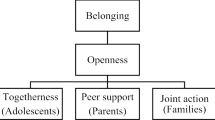Abstract
Behavioral family interventions are an effective way to intervene to prevent negative developmental outcomes for adolescents. Participation in family interventions encompasses behavioral and cognitive/attitudinal dimensions, among others, indicated by retention and engagement, respectively. Two dimensions of participation, retention and engagement, in a family intervention were examined in a sample of newly homeless adolescents and their parents or guardians. Correlates of participation included parents with more income and less perceived family conflict and adolescents with higher endorsement of depression, anxiety, somatization, obsessive-compulsive, phobic, and psychotic symptoms on the Brief Symptom Inventory (BSI). Stronger therapeutic alliance was correlated with being more distressed (i.e., lower income, more hostility), being a female adolescent participant, and having greater comfort discussing sex with parents. Furthermore, parents and adolescents with greater distress and thus greater need were more apt to finish the intervention. The finding that families who were experiencing more distress had higher alliance scores suggests that there is an additional need for development of interventions for families in crisis. Both participant and provider perceptions are also important in development of a strong therapeutic alliance. This study’s findings have implications for further exploration of the development of cultural humility and improving mental health literacy among facilitators of behavioral interventions.
Similar content being viewed by others
References
Bloom, B. L. (1985). A factor analysis of self-report measures of family functioning. Family Process, 24, 255–239. https://doi.org/10.1111/j.1545-5300.1985.00225.x.
Bray, J. H., & Pequegnat, W. (2012). Statistical challenges in studying complex and changing families. AIDS and Behavior, 16, 441–451. https://doi.org/10.1007/s10461-011-9881-6.
Busseri, M. A., & Tyler, J. D. (2003). Interchangeability of the working alliance inventory and working alliance inventory, short form. Psychological Assessment, 15, 193–197.
Coatsworth, J. D., Duncan, L. G., Pantin, H., & Szapocznik, J. (2006). Patterns of retention in a preventive intervention with ethnic minority families. The Journal of Primary Prevention, 27, 171–193. https://doi.org/10.1007/s10935-005-0028-2.
Coatsworth, J. D., Hemady, K. T., & George, M. S. (2018). Predictors of group leaders’ perceptions of parents’ initial and dynamic engagement in a family preventive intervention. Prevention Science, 19, 609–619.
Cohen, J. (1992). A power primer. Psychological Bulletin, 112, 155–159.
Collins, N. L., & Read, S. J. (1990). Adult attachment, working models, and relationship quality in dating couples. Journal of Personality and Social Psychology, 58, 644–663.
Derogatis, L. R. (1993). BSI brief symptom inventory: Administration, scoring, and procedure manual (4th ed.). Minneapolis: National Computer Systems.
Donenberg, G. R., Emerson, E., Bryant, F. B., Wilson, H., & Weber-Shifrin, E. (2001). Understanding AIDS-risk behavior among adolescents in psychiatric care: Links to psychopathology and peer relationships. Journal of the American Academy of Child and Adolescent Psychiatry, 40, 642–653.
Elvins, R., & Green, J. (2008). The conceptualization and measurement of therapeutic alliance: An empirical review. Clinical Psychology Review, 28, 1167–1187.
Fryer, C. S., Passmore, S. R., Maietta, R. C., Petruzzelli, J., Casper, E., Brown, N. A., et al. (2016). The symbolic value and limitations of racial concordance in minority research engagement. Qualitative Health Research, 26, 830–841. https://doi.org/10.1177/1049732315575708.
Garland, A. F., Lau, A. S., Yeh, M., McCabe, K. M., Hough, R. L., & Landsverk, J. A. (2005). Racial and ethnic differences in utilization of mental health services among high-risk youths. American Journal of Psychiatry, 162, 1336–1343.
Gavin, D. R., Ross, H. E., & Skinner, H. A. (1989). Diagnostic validity of the drug abuse screening test in the assessment of DSM-III drug disorders. British Journal of Addiction, 84, 301–307.
Gratz, K. L., & Roemer, L. (2004). Multidimensional assessment of emotion regulation and dysregulation: Development, factor structure, and initial validation of the difficulties in emotion regulation scale. Journal of Psychopathology and Behavioral Assessment, 26, 41–54.
Holm, S. (1979). A simple sequentially rejective multiple test procedure. Scandinavian Journal of Statistics, 6, 65–70.
Ingoldsby, E. (2010). Review of interventions to improve family engagement and retention in parent and child mental health programs. Journal of Child and Family Studies, 19, 629–645. https://doi.org/10.1007/s10826-009-9350-2.
Kapungu, C., Nappi, C., Thakral, C., Miller, S., Devlin, C., McBride, C., et al. (2012). Recruiting and retaining high-risk adolescents into family-based HIV prevention intervention research. Journal of Child and Family Studies, 21, 578–588.
Kazdin, A. E., Holland, L., & Crowley, M. (1997). Family experience of barriers to treatment and premature termination from child therapy. Journal of Consulting and Clinical Psychology, 65, 453–463.
Martino, S., Grilo, C. M., & Fehon, D. C. (2000). Development of the drug abuse screening test for adolescents (DAST-A). Addictive Behaviors, 25, 57–70.
Mauricio, A. M., Gonzales, N., & Sandler, I. N. (2018). Preventive parenting interventions: Advancing conceptualizations of participation and enhancing reach. Prevention Science, 19, 603–608.
McConnaughy, E. A., Prochaska, J. O., & Velicer, W. F. (1983). Stages of change in psychotherapy: Measurement and sample profiles. Psychotherapy: Theory, Research, and Practice, 20, 368–375.
Milburn, N. G., & Lightfoot, M. (2016). Improving the participation of families of color in evidence-based interventions: Challenges and lessons learned. In N. Zane, G. Bernal, & F. L. Leong (Eds.), Evidence-based psychotherapy practice with ethnic minorities: Culturally informed research and clinical strategies (pp. 273–287). Washington, DC: American Psychological Association. https://doi.org/10.1037/14940-013.
Milburn, N. G., Rosenthal, D., Rotheram-Borus, M. J., Mallett, S., Batterham, P., Rice, E., & Solorio, R. (2007). Newly homeless youth typically return home. Journal of Adolescent Health, 40, 574–576. https://doi.org/10.1016/j.jadohealth.2006.12.017.
Milburn, N. G., Rice, E., Rotheram-Borus, M. J., Mallett, S., Rosenthal, D., Batterham, P., et al. (2009). Adolescents exiting homelessness over two years: The risk amplification and abatement model. Journal of Research on Adolescence, 19, 762–785.
Milburn, N. G., Iribarren, F. J., Rice, E., Lighfoot, M., Solorio, R., Rotheram-Borus, M. J., et al. (2012). A family intervention to reduce sexual risk behavior, substance use, and delinquency among newly homeless youth. Journal of Adolescent Health, 50, 358–364. https://doi.org/10.1016/j.jadolhealth.2011.08.009.
Murry, V. M., Berkel, C., & Liu, N. (2018). The closing digital divide: Delivery modality and family attendance in the pathways for African American success (PAAS) program. Prevention Science, 19, 642–651. https://doi.org/10.1007/s11121-018-0863-z.
Orrell-Valente, J. K., Pinderhughes, E. E., Valente Jr., E., Laired, R. D., Bierman, K. L., Coie, J. D., et al. (1999). If it’s offered, will they come? Influences on parents’ participation in a community-based conduct problems prevention program. American Journal of Community Psychology, 27, 753–784.
Parker, G., Tupling, H., & Brown, L. B. (1979). A parental bonding instrument. British Journal of Medical Psychology, 52, 1–10. https://doi.org/10.1111/j.2044-8341.1979.tb02487.x.
Pergamit, M., Gelatt, J., Straford, B., Beckwith, S., & Martin, M. C. (2016). Family interventions for youth experiencing or at risk of homelessness. Washington, DC: Urban Institute.
Rotheram-Borus, M. J., Goldstein, A. M., & Elkavich, A. S. (2002). Treatment of suicidality: A family intervention for adolescent suicide attempters. In S. G. Hofmann & M. C. Thompson (Eds.), Treating chronic and severe mental disorders: A handbook of empirically supported interventions (pp. 191–212). New York: Guilford Press.
Selzer, M. L. (1971). The Michigan alcoholism screening test (MAST): The quest for a new diagnostic instrument. American Journal of Psychiatry, 127, 1653–1658.
Selzer, M. L., Vinokur, A., & van Rooijen, L. (1975). A self-administered short Michigan alcoholism screening test (SMAST). Journal of Studies on Alcohol, 36, 117–126.
Skinner, H. A. (1982). The drug abuse screening test. Addictive Behaviors, 7, 363–371.
Snell-Johns, J., Mendez, J. L., & Smith, B. H. (2004). Evidenced-based solutions for overcoming access barriers, decreasing attrition, and promoting change with underserved families. Journal of Family Psychology, 18, 19–35. https://doi.org/10.1037/0893-3200.18.1.19.
Spoth, R., & Redmond, C. (2000). Research on family engagement in preventive interventions: Toward improved use of scientific findings in primary prevention practice. The Journal of Primary Prevention, 21, 267–284. https://doi.org/10.1023/A:1007039421026.
Spoth, R., Rohrbach, L. A., Greenberg, M., Leaf, P., Brown, C. H., Fagan, A., et al. (2013). Addressing core challenges for the next generation type 2 translational research and systems: The translation science to population impact (TSci Impact) framework. Prevention Science, 14, 319–351.
Staudt, M. (2007). Treatment engagement with caregivers of at-risk children: Gaps in research and conceptualization. Journal of Child and Family Studies, 16, 183–196.
Steinberg, A. M., Brymer, M., Decker, K., & Pynoos, R. S. (2004). The UCLA PTSD reaction index. Current Psychiatry Reports, 6, 96–100.
Strauss, M. A. (1979). Measuring intrafamily conflict and violence: The conflict tactics scales. Journal of Marriage and the Family, 41, 75–88.
Thompson, S., Bender, K., Lantry, J., & Flynn, P. (2007). Treatment engagement: Building therapeutic alliance in home-based treatment with adolescents and their families. Contemporary Family Therapy: An International Journal, 29, 39–55.
Tyler, K. A., & Schmitz, R. M. (2013). Family histories and multiple transitions among homeless young adults: Pathways to homelessness. Children and Youth Services Review, 35, 1719–1726. https://doi.org/10.1016/j.childyouth.2013.07.014.
Winslow, E. B., Bonds, D., Wolchik, S., Sandler, I., & Braver, S. (2009). Predictors of enrollment and retention in a preventive parenting intervention for divorced families. Journal of Primary Prevention, 30, 151–172. https://doi.org/10.1007/s10935-009-0170-3.
Funding
This research was supported by grants from the National Institute on Drug Abuse (DA035692, DA024955), the National Institute of Mental Health (MH70322), and the National Institute on Minority Health and Health Disparities (P20MD000182).
Author information
Authors and Affiliations
Corresponding author
Ethics declarations
Conflict of Interest
The authors declare that they have no conflict of interest.
Ethical Approval
All data collection procedures were carried out with approval from, and in compliance with, the Institutional Review Board of the University of California, Los Angeles.
Informed Consent
Informed consent was obtained from all individual participants in the study.
Additional information
Publisher’s Note
Springer Nature remains neutral with regard to jurisdictional claims in published maps and institutional affiliations.
Electronic supplementary material
ESM 1
(DOC 115 kb)
Rights and permissions
About this article
Cite this article
Milburn, N.G., Klomhaus, A.M., Comulada, W.S. et al. Reconnecting Homeless Adolescents and Their Families: Correlates of Participation in a Family Intervention. Prev Sci 21, 1048–1058 (2020). https://doi.org/10.1007/s11121-020-01157-9
Published:
Issue Date:
DOI: https://doi.org/10.1007/s11121-020-01157-9




